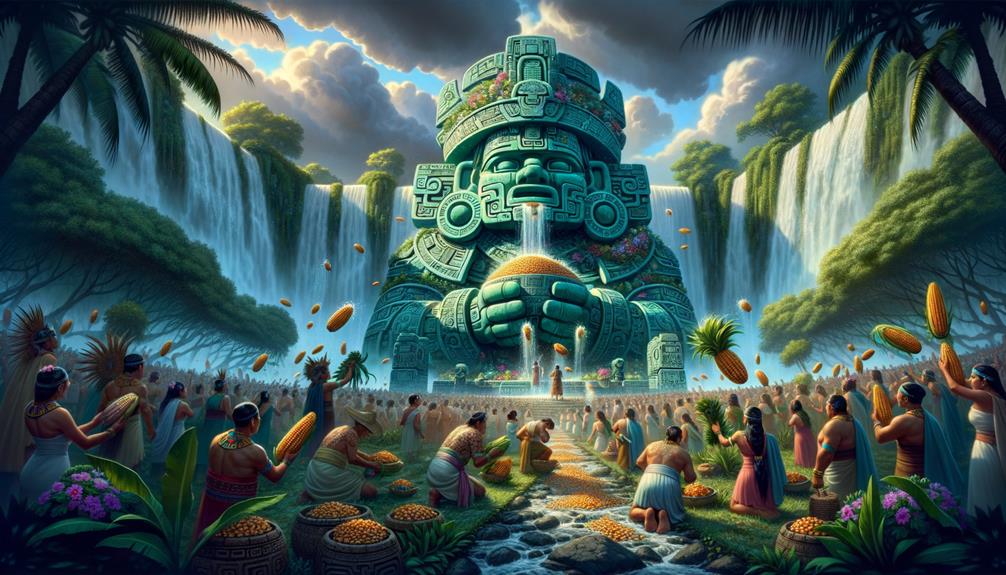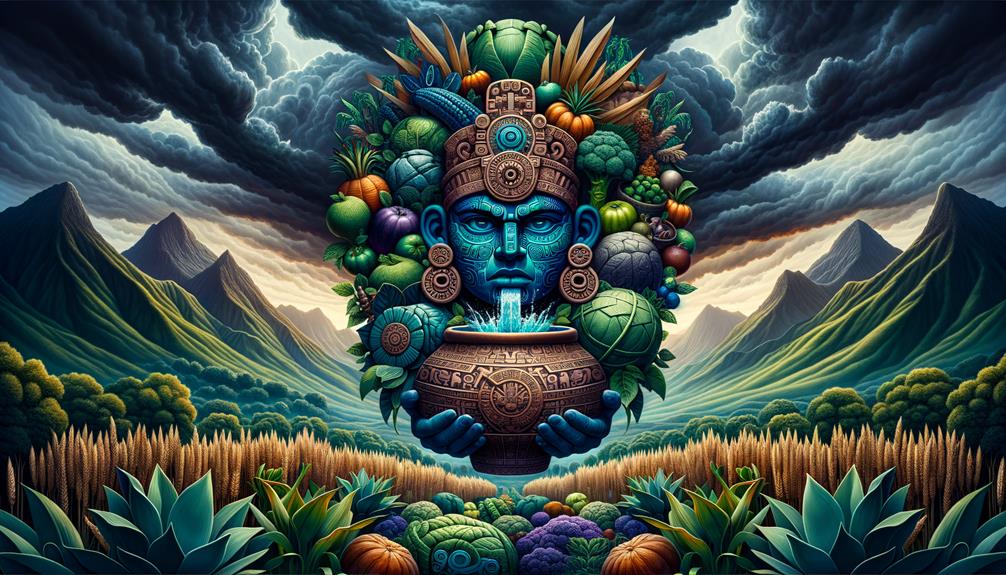Tlaloc, the Aztec Rain Agriculture God, shares striking similarities with rain deities across mythologies like the Hindu Indra and Greek Zeus. These gods personified humanity's reliance on water for sustenance and agricultural prosperity. Tlaloc governed not just the earthly realm but also Tlalocan, a paradise awaiting those who perished by water. This duality raises thought-provoking questions about Aztec beliefs surrounding life, death, and nourishment.
Tlaloc's Characteristics
In the Aztec belief system, Tlaloc reigned as the deity overseeing water, agriculture, and fertility – the pillars ensuring the civilization's survival and prosperity. His influence was deeply rooted in controlling water resources, crucial for successful crops and bountiful harvests. The Templo Mayor's pillars, adorned with symbols of eyes and blue bands, proudly displayed Tlaloc's connection to these life-sustaining elements.
Tlaloc's domain extended to Tlalocan, a paradisiacal realm where he benevolently ruled alongside supernatural beings known as Tlaloques. Together, they managed rain distribution, ensuring the seasons' cyclical patterns so vital for agricultural triumphs. Tlaloc's governance over the 13-day sequence in the 260-day ritual calendar reinforced the Aztec rulers' authority and their symbiotic relationship with nature.
Solemn rituals and sacrifices, including the heart-wrenching offering of children during ceremonies like Tozoztontli, were paramount to appeasing Tlaloc and securing continued fertility and ample rainfall. These acts highlighted the profound link between the Aztecs' spiritual practices and their agricultural needs, cementing Tlaloc's central role in their cosmology.
Worship and Rituals

The Aztecs relied heavily on Tlaloc, their god of rain and agriculture. Months like Atlacahualo and Tozoztontli were dedicated to worshipping him, marking key periods in the agricultural cycle. Rituals involved offerings like food, goods, and human sacrifices to secure Tlaloc's favor for fertile lands and ample water.
For the deceased, seeds were planted on their faces, symbolizing hopes for rebirth and future fertility. This practice highlighted the cycle of life and death, a recurring theme across mythologies. Tlaloc's temple atop the Templo Mayor in Tenochtitlan underscored his supreme significance. Those living righteously could journey to Tlalocan, a heavenly realm, reflecting the belief that divine approval determined one's afterlife.
Through these ceremonies, the Aztecs revealed their profound understanding of water's influence on power and fertility – vital elements shaping their worldview and daily existence.
Temples and Shrines

Among Tenochtitlan's impressive structures stood the Templo Mayor's shrine honoring Tlaloc, the god governing agriculture and water. This sacred space, adorned with pillars representing Tlaloc's eyes and blue bands, highlighted his pivotal role in ensuring fertility and abundance for the Aztec people.
Offerings like sacrificed water animals and jade objects aimed to appease Tlaloc and secure bountiful rains. A high priest meticulously tended these offerings, bridging the mortal and divine realms. This practice underscored humanity's reliance on higher powers for survival, a universal theme across mythologies.
Beyond Tenochtitlan, Mount Tlaloc served as another revered site where Aztec rulers and priests embarked on pilgrimages. This mountain shrine facilitated profound offerings and ceremonies, reinforcing Tlaloc's sacred bond with his devotees. The duality of urban and natural shrines accentuated Tlaloc's pervasive influence in Aztec life.
Depictions and Iconography

Tlaloc's visuals pack a punch, with consistent features like ringed eyes, fanged mouth, and mustache-shaped lip symbolizing his reign over rain and water in Aztec beliefs. His iconography delves deep into natural elements and his agricultural, rain deity status. Massive goggles for eyes and jaguar traits emphasize his fierce, protective nature.
Serpents form his nose, raindrops surround him, and he wields a lightning-thunder scepter – not mere artistic flairs but potent Aztec symbols. Here's what they represent:
| Element | Symbolism |
|---|---|
| Ringed Eyes | Vision, vigilance, divine sight |
| Fanged Mouth | Power, ferocity, protection |
| Mustache-shaped Lip | Water and fertility |
| Serpents (Nose) | Lightning and rain connection |
| Raindrops and Scepter | Weather and agriculture control |
Water lilies often appear, linking him to life-giving aqua. The Tlaloques, his helpers, frequently accompany him, reinforcing his pivotal rain god role. These vivid depictions reveal how deeply Aztecs revered the natural elements sustaining their agricultural lives.
Historical Significance

Tlaloc shines as an integral part of Aztec culture, embodying the primal forces of water, fertility, and agricultural prosperity. More than just a mythical figure, this deity permeated every corner of life, cementing the unbreakable link between nature and human survival. Tlaloc's shrine at the Templo Mayor in Tenochtitlan signified agriculture and water's paramount role in Aztec society.
Rituals, tributes, even human sacrifice, aimed to curry Tlaloc's favor – not mere superstition but calculated efforts to uphold societal order and political legitimacy. During droughts, child sacrifice in ceremonies like Tozoztontli invoked this god's rainy benevolence, laying bare the Aztecs' existential dependence on Tlaloc.
Sacred mountain shrines, such as atop Mount Tlaloc, embodied the deep veneration for this divine force. These hallowed spaces supposedly brought worshippers nearer Tlaloc's realm, augmenting rituals' potency. Through these practices, Tlaloc's enduring significance underscores the Aztecs' intricate cosmological understanding of life, death, and rebirth's eternal cycle.
Frequently Asked Questions
Was Tlaloc the God of Rain?
Tlaloc governed rainfall, a vital force shaping agriculture and survival in ancient Mesoamerica. As a divine embodiment of nature's creative and destructive duality, his influence extended beyond crops, impacting health and life itself. This rain deity wielded immense power as a complex divine force.
Is Tlaloc the God of Rain Water Lightning and Agriculture?
Tlaloc, an Aztec deity, governs rain, water sources, lightning storms, and agricultural prosperity. This divine persona personifies the vital natural forces that nurture crops and ensure bountiful harvests, echoing similar deities from different mythologies.
Who Is the Aztec God of Agriculture?
The Aztec deity Tlaloc oversaw agriculture and rain, essential for flourishing crops like maize. This god personified the cycle of growth through control over water and fertility. The Aztecs recognized a profound link between divine forces and the earth's bounty, valuing Tlaloc as a central figure guiding their agricultural prosperity.
Who Is the Aztec Goddess of Rain?
Chalchiuhtlicue, the Aztec deity of freshwater, nourished life alongside Tlaloc, her male counterpart. Their partnership embodied balance – she represented feminine power sustaining crops through rain and moisture. Ancient civilizations often depicted archetypes of duality, reflecting nature's cycles. Chalchiuhtlicue's mythology underscores the interdependence of opposing yet complementary forces in the cosmos.


